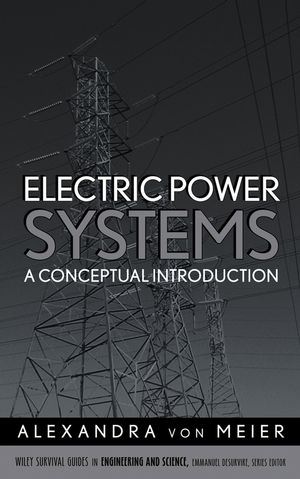Electric Power Systems: A Conceptual IntroductionISBN: 978-0-471-17859-0
Hardcover
328 pages
July 2006, Wiley-IEEE Press
 This is a Print-on-Demand title. It will be printed specifically to fill your order. Please allow an additional 15-20 days delivery time. The book is not returnable.
|
||||||
1. The Physics of Electricity.
1.1 Basic Quantities.
1.1.1 Introduction.
1.1.2 Charge.
1.1.3 Potential or Voltage.
1.1.4 Ground.
1.1.5 Conductivity.
1.1.6 Current.
1.2 Ohm’s law.
1.2.1 Resistance.
1.2.2 Conductance.
1.2.3 Insulation.
1.3 Circuit Fundamentals.
1.3.1 Static Charge.
1.3.2 Electric Circuits.
1.3.3 Voltage Drop.
1.3.4 Electric Shock.
1.4 Resistive Heating.
1.4.1 Calculating Resistive Heating.
1.4.2 Transmission Voltage and Resistive Losses.
1.5 Electric and Magnetic Fields.
1.5.1 The Field as a Concept.
1.5.2 Electric Fields.
1.5.3 Magnetic Fields.
1.5.4 Electromagnetic Induction.
1.5.5 Electromagnetic Fields and Health Effects.
1.5.6 Electromagnetic Radiation.
2. Basic Circuit Analysis.
2.1 Modeling Circuits.
2.2 Series and Parallel Circuits.
2.2.1 Resistance in Series.
2.2.2 Resistance in Parallel.
2.2.3 Network Reduction.
2.2.4 Practical Aspects.
2.3 Kirchhoff’s Laws.
2.3.1 Kirchhoff’s Voltage Law.
2.3.2 Kirchhoff’s Current Law.
2.3.3 Application to Simple Circuits.
2.3.4 The Superposition Principle.
2.4 Magnetic Circuits.
3. AC Power.
3.1 Alternating Current and Voltage.
3.1.1 Historical Notes.
3.1.2 Mathematical Description.
3.1.3 The rms Value.
3.2 Reactance.
3.2.1 Inductance.
3.2.2 Capacitance.
3.2.3 Impedance.
3.2.4 Admittance.
3.3 Power.
3.3.1 Definition of Electric Power.
3.3.2 Complex Power.
3.3.3 The Significance of Reactive Power.
3.4 Phasor Notation.
3.4.1 Phasors as Graphics.
3.4.2 Phasors as Exponentials.
3.4.3 Operations with Phasors.
4. Generators.
4.1 The Simple Generator.
4.2 The Synchronous Generator.
4.2.1 Basic Components and Functioning.
4.2.2 Other Design Aspects.
4.3 Operational Control of Synchronous Generators.
4.3.1 Single Generator: Real Power.
4.3.2 Single Generator: Reactive Power.
4.3.3 Multiple Generators: Real Power.
4.3.4 Multiple Generators: Reactive Power.
4.4 Operating Limits.
4.5 The Induction Generator.
4.5.1 General Characteristics.
4.5.2 Electromagnetic Characteristics.
4.6 Inverters.
5. Loads.
5.1 Resistive Loads.
5.2 Motors.
5.3 Electronic Devices.
5.4 Load from the System Perspective.
5.4.1 Coincident and Noncoincident Demand.
5.4.2 Load Profiles and Load Duration Curve.
5.5 Single- and Multiphase Connections.
6. Transmission and Distribution.
6.1 System Structure.
6.1.1 Historical Notes.
6.1.2 Structural Features.
6.1.3 Sample Diagram.
6.1.4 Topology.
6.1.5 Loop Flow.
6.1.6 Stations and Substations.
6.1.7 Reconfiguring the System.
6.2 Three-Phase Transmission.
6.2.1 Rationale for Three Phases.
6.2.2 Balancing Loads.
6.2.3 Delta and Wye Connections.
6.2.4 Per-Phase Analysis.
6.2.5 Three-Phase Power.
6.2.6 D.C. Transmission.
6.3 Transformers.
6.3.1 General Properties.
6.3.2 Transformer Heating.
6.3.3 Delta and Wye Transformers.
6.4 Characteristics of Power Lines.
6.4.1 Conductors.
6.4.2 Towers, Insulators, and Other Components.
6.5 Loading.
6.5.1 Thermal Limits.
6.5.2 Stability Limit.
6.6 Voltage Control.
6.7 Protection.
6.7.1 Basics of Protection and Protective Devices.
6.7.2 Protection Coordination.
7. Power Flow Analysis.
7.1 Introduction.
7.2 The Power Flow Problem.
7.2.1 Network Representation.
7.2.2 Choice of Variables.
7.2.3 Types of Buses.
7.2.4 Variables for Balancing Real Power.
7.2.5 Variables for Balancing Reactive Power.
7.2.6 The Slack Bus.
7.2.7 Summary of Variables.
7.3 Example with Interpretation of Results.
7.3.1 Six-Bus Example.
7.3.2 Tweaking the Case.
7.3.3 Conceptualizing Power Flow.
7.4 Power Flow Equations and Solution Methods.
7.4.1 Derivation of Power Flow Equations.
7.4.2 Solution Methods.
7.4.3 Decoupled Power Flow.
7.5 Applications and Optimal Power Flow.
8. System Performance.
8.1 Reliability.
8.1.1 Measures of Reliability.
8.1.2 Valuation of Reliability.
8.2 Security.
8.3 Stability.
8.3.1 The Concept of Stability.
8.3.2 Steady-State Stability.
8.3.3 Dynamic Stability.
8.3.4 Voltage Stability.
8.4 Power Quality.
8.4.1 Voltage.
8.4.2 Frequency.
8.4.3 Waveform.
9. System Operation, Management, and New Technology.
9.1 Operation and Control on Different Time Scales.
9.1.1 The Scale of a Cycle.
9.1.2 The Scale of Real-Time Operation.
9.1.3 The Scale of Scheduling.
9.1.4 The Planning Scale.
9.2 New Technology.
9.2.1 Storage.
9.2.2 Distributed Generation.
9.2.3 Automation.
9.2.4 FACTS.
9.3 Human Factors.
9.3.1 Operators and Engineers.
9.3.2 Cognitive Representations of Power Systems.
9.3.3 Operational Criteria.
9.3.4 Implications for Technological Innovation.
9.4 Implications for Restructuring.
Appendix: Symbols, Units, Abbreviations, and Acronyms.
Index.



